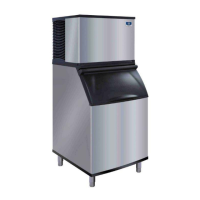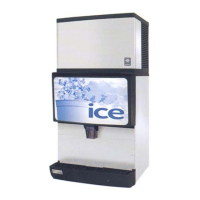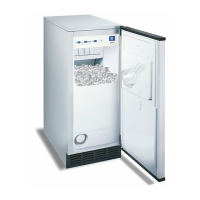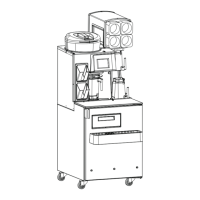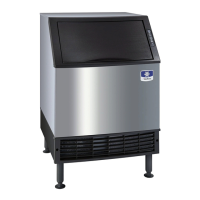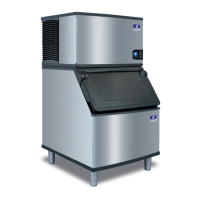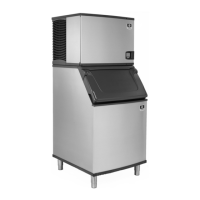Do you have a question about the Manitowoc MD1000A and is the answer not in the manual?
| Model | MD1000A |
|---|---|
| Ice Production Capacity | 1000 lbs per day |
| Refrigerant | R-404A |
| Water Connection | 3/8 inch |
| Type | Modular Ice Maker |
| Ice Type | Dice |
| Storage Capacity | Not applicable (modular unit) |
| Dimensions (H x W x D) | 29.5 x 30 x 24 inches |
Text in boxes alerts to personal injury or equipment damage situations.
Proper installation, care, and maintenance are essential for performance.
Routine adjustments and maintenance are not covered by warranty.
Read manual before operating, installing, or maintaining equipment.
Do not use non-Manitowoc electrical appliances or accessories.
Two or more people or a lifting device are required to lift the appliance.
Trained technicians must handle high voltage and refrigerant safely.
Avoid damaging the refrigeration circuit during installation or servicing.
Do not operate equipment that has been misused, abused, neglected, or altered.
Ensure all covers and access panels are in place and secured before operation.
Do not obstruct machine vents or openings.
Do not store flammable vapors or liquids near the appliance.
Do not clean the unit using a water jet.
Owner must perform PPE hazard assessment for maintenance.
Use two or more people or a lifting device to move equipment to prevent tipping.
Ice machines contain high voltage and refrigerant; repairs require trained technicians.
Do not mix cleaner and sanitizer solutions together.
Disconnect electric power before proceeding with part removal.
Inspect and adjust ice bridge thickness for proper ice cube formation.
Procedure to enter and use the control board test mode.
High voltage warning: always applied to the control board.
Relates ice production to operating temperatures and provides a formula.
Identifies potential water-related problems and their causes.
Procedure to analyze discharge pressure based on operating conditions.
Checks for low discharge pressure during the freeze cycle.
Procedure to analyze suction pressure drop throughout the freeze cycle.
Discusses valve failure modes and symptoms.
Procedure to compare evaporator temperatures to diagnose malfunctions.
Importance of discharge line temperature for diagnostics.
How to measure maximum discharge line temperature.
Introduction to the tables for diagnosing refrigeration components.
Steps for completing the operational analysis and final analysis.
Interprets results to identify refrigeration problems.
Chart correlating operational analysis, ice production, and ice formation patterns.
Procedure for checking compressor winding resistance.
Procedure to check for grounded compressor windings.
Diagnosing locked rotor issues caused by defective start components or seizure.
Troubleshooting high amperage draw on startup.
The HPR system is not used during the freeze cycle.
Operation of the HPR system during the harvest cycle.
Diagnostic steps for the HPR system.
Procedures for recovering and recharging refrigerant.
Replace liquid line drier; no responsibility for contaminated refrigerant use.
Procedure for self-contained units.
Detailed steps for charging the refrigerant system.
Use scale/cylinder for proper charge.
Identifying contamination causes like moisture or burnout residue.
